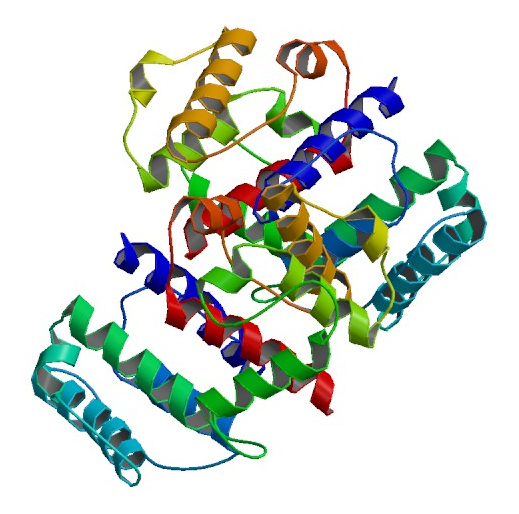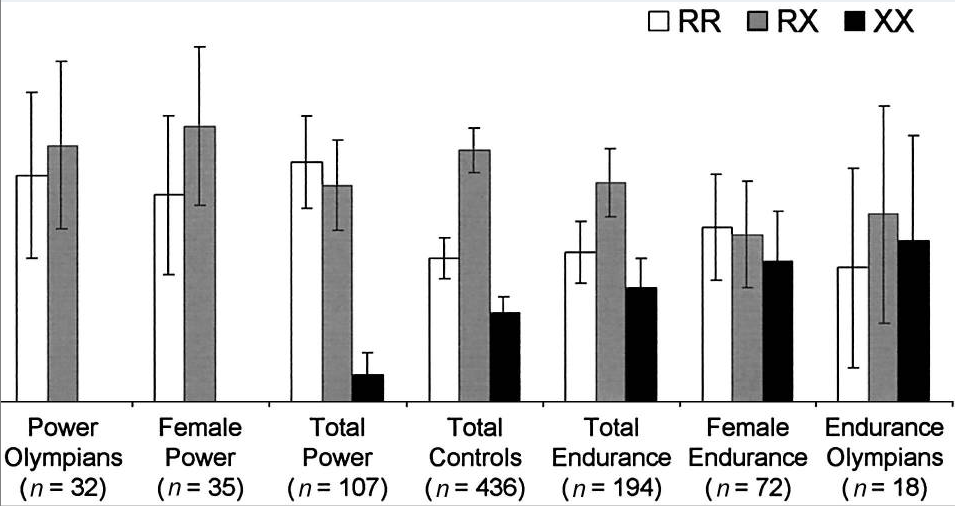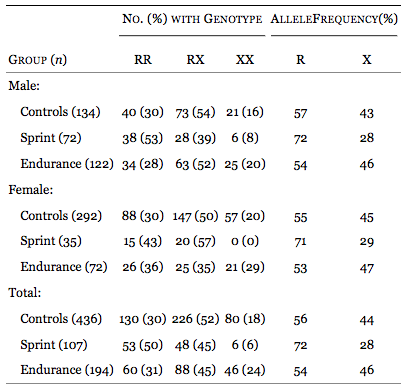
ACTN3 - The Athletic Gene?
This web page was produced as an assignment for an undergraduate
course at Davidson College.

Representation of the 3D structure of alpha-actinin-3, the protein product of the ACTN3 577R allele. Image from Protein Data Bank. Publicly available.
The Science
The ACTN3 gene and its impacts on human athleticism were first characterized by Yang et al., in their 2003 paper in The American Journal of Human Genetics. The ACTN3 gene has two alleles: ACTN3 577R, which produces the protein alpha-actinin-3, and ACTN3 577X, which does not a produce a functional protein due to a premature stop codon. Individuals with at least one copy of the 577R allele have alpha-actinin-3 present in their fast-twitch muscle fibers – the type of muscle fiber recruited during high-power, anaerobic exercise. Alpha-actinin-3 serves to help link actin filaments together in the sarcomere and Yang et al., hypothesized that it allows fast-twitch muscle fibers to contract with greater force.
In their paper, Yang et al., showed that the 577R allele had an increased frequency among elite athletes competing in power-based events (Fig. 1). They sampled 436 control individuals and 429 elite (elite being defined as having represented their country at a national level) athletes competing in power- and endurance-based events, and sequenced their DNA to determine ACTN3 genotype. 50% of power athletes were homozygous for the 577R allele (577RR genotype), compared to only 30% of the control group (Fig 2). In addition, only 6% of power athletes had the 577XX genotype, compared to 18% of the control group (Fig 2). These trends were even more pronounced in female power athletes, almost 60% of whom were 577RR, and not a single female power athlete was 577XX (Fig 2). However, the 577XX allele was more common among elite endurance athletes, 24% of whom were 577XX, as opposed to 18% of control individuals (Fig 2). The 577RX genotype was less common in female endurance athletes, though this trend was not observed in male endurance athletes (Fig 2).

Fig 1. Histogram of ACTN3 genotypes in elite athletes participating in power events or endurance events versus a control sample. Image from Yang et al., 2003. Publicly available.

Fig 2. ACTN3 genotype and allele frequencies in elite male and female power and endurance athletes, versus a control sample. Image from Yang et al., 2003. Publicly available.
These data suggest that the 577R allele (and thus the presence of alpha-actinin-3) may confer an advantage in power-based athletic events, while the 577X allele may confer an advantage in endurance-based events. However, Yang et al., note that the data behind 577R providing a power advantage are more statistically powerful than the data suggesting that 577X provides an endurance advantage. In addition, gender seems to play an important role in the link between ACTN3 genotype and athletic performance – in general, genotype frequency trends seem to be more pronounced in female athletes. In addition, only white individuals were sampled, so it remains to be seen if certain races are correlated with genotypes. Yang et al., also note that these apparent differences in genotype frequency may only emerge among the highest level of athletes; other factors like diet and training are probably far more important factors in athletic performance at the sub-elite level. Yang et al., also point out that at the time of their writing, 73 genes had been identified as having an impact on fitness and sports performance and most of them have not been studied to the extent that ACTN3 has. As such, it would be incorrect to link a trait as complex as athletiscism to solely to one gene.
The Popular Press
As a whole, the popular press articles largely get the facts about ACTN3 right. However, they overgeneralize about the impact of ACTN3 genotype and lack important contextual and sociological information. The Euronews article, for example, spends about the first two-thirds of its length speaking rather vaguely about the relationship between genetics and sports performance. No particular studies or individual genes are mentioned, with the only data coming in the form of a couple of quotes. One scientist is quoted saying, “The genetic component [of sports performance] seems to be around 50-70%.” This percentage is pulled out rather abruptly, and the article makes no mention about how this figure was calculated. It doesn’t discuss what athletic traits might be affected by genetics or what genes are responsible for those traits. To me, it seems arbitrary to assign a percentage to the extent to which a trait like athleticism can be attributed to genetics. How do you weigh a gene versus diet, exercise, and practice? Perhaps the quoted scientist was justified in using his 50-70% figure, but without providing any sort of context behind this number, it doesn’t really have any meaning.
The article goes on to quote scientists talking about how “favourable” and “unfavourable” genes, or “good genes” and “less good genes” can have impacts on athleticism. I find these terms to be equally meaningless without context. No specific genes are named. What exactly makes a gene good or bad for athletic performance, and how are these traits identified and evaluated? The last third or so of the article delves into ACTN3 specifically. It correctly characterizes ACTN3, but leaves out important parts of the bigger picture. For example, the article says “the billion or so people who lack the 577R allele might want to reconsider their Olympic aspirations.” This statement is really overemphasizing the importance of the 577R allele to athletic success: the data from Yang et al., reveals that elite endurance athletes are more likely to be 577XX than controls, and there are even several 577XX power athletes.
The article also does not address the gender-based differences raised by Yang et al., or evaluate the relative importance of traditional athletic training. The article ends by raising the ethical question of “gene doping”, but doesn’t define the term or address any of the implications of such a practice. If the Euronews article implemented some of the recommendations outline in Kua et al., they could improve their article significantly, and readers could take away much more knowledge about the science behind the article. Given the broad scope of the article, I think it would have been appropriate to specifically cite more than one gene as responsible for athletic performance, but given that the only address ACTN3, it certainly should have been handled better. Kua et al., outline a clear set of parameters that popular science articles should live up to, and I will evaluate the Euronews article by these parameters below:
The Scientific American article, by Jordan Lite, does a better job of contextualizing the scientific findings. The article begins by introducing Atlas Sports Genetics, a website that is selling a DNA sequencing service that can determine a person’s ACTN3 genotype. The creator of the website, Kevin Rielly, is quoted as acknowledging that ACTN3 is only one of many tools in evaluating a child’s potential for athleticism. Rielly also says that his service is best used to select when sport you child may be most suited to. This is a particularly important difference from the Euronews article. Rather than suggesting that ACTN3 genotype determines a person’s athleticism, the article shows that ACTN3 status may be indicative of a certain type of athleticism: endurance or power. This is an assertion that is supported by the data from Yang et al. I think the Euronews article overgeneralizes the importance of ACTN3 as a black-and-white, athletic vs. un-athletic indicator. The Scientific American article gets more at the truth, which is is that Yang et al., found Olympians of every ACTN3 genotype, and that your ACTN3 genotype is less a marker of athleticism than an indicator of what type of sport you may be predisposed toward.
Lite goes on in the article to outline the facts about ACTN3, and then transitions into an interview with Dr. Stephen Roth, who speaks about the relationship between genes and athletic ability. The conversation Lite has with Roth also does a better job than the Euronews article acknowledging the sociology of science. Roth points out the struggle to design studies that effectively measure athleticism. Roth also references past research, points out other specific genes related to athleticism, and overall emphasizes that athleticism is a complex trait that is not as cut and dry as a single gene. Below I evaluate the article via the parameters outlined by Kua et al.
Overall, I find the Scientific American article to be a a better popular science article than the Euronews article. The Scientific American article does a better job of contextualizing the information, and includes more background and information on the sociology of science. A lay-reader would be much more informed about ACTN3 and the relationship between genotypes and athleticism if they read the Scientific American article rather than the Euronews article.
References
"Born to Run? How Our Genes Affect Our Sporting Talent." Euronews. N.p., 31 July 2012. Web. 27 Jan. 2013.
Kua, Eunice, Michael Reder, and Martha J. Grossel. "Science in the News: A Study of Reporting Genomics." Public Understanding of Science 13 (2004): 309-32. Web. 27 Jan. 2013.
Lite, Jordan. "Can Genes Predict Athletic Performance?" Scientific American, 1 Dec. 2008. Web. 27 Jan. 2013.
Yang, N., D. G. MacArthur, J. P. Gulbin, A. G. Hahn, A. H. Beggs, S.
Esteal, and K. North. "ACTN3 Genotype Is Associated with Human Elite
Athletic Performance." National Center for Biotechnology Information. U.S. National Library of Medicine, 23 July 2003. Web. 27 Jan. 2013.
Erich Baker's Homepage
Genomics Page
Biology Home Page
Email Questions or Comments to erbaker@davidson.edu or macampbell@davidson.edu
© Copyright 2013 Department of Biology, Davidson College, Davidson, NC 28035